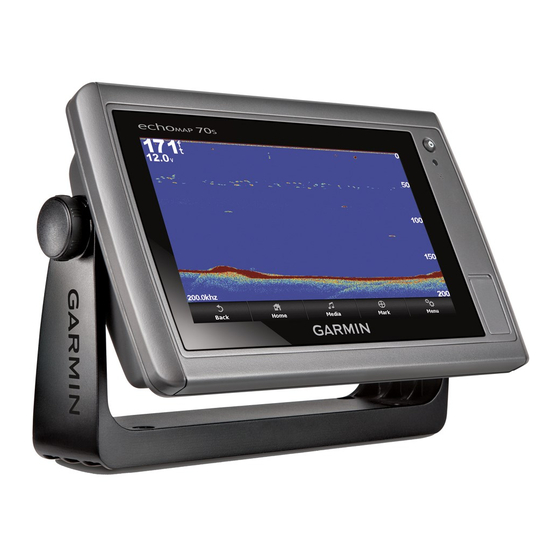1
From a chart or 3D chart view, select Menu.
2
If necessary, select Chart Setup.
3
Select Overlay Numbers > Navigation Inset > Auto.
4
Select Navigation Inset Setup.
5
Complete an action:
• To show waypoint velocity made good (VMG) when
navigating a route with more than one leg, select Route
Leg Details > On.
• To show next-turn data based on distance, select Next
Turn > Distance.
• To show next-turn data based on time, select Next Turn >
Time.
• To indicate how the destination data appears, select
Destination, and select an option.
Chart Appearance Settings
You can adjust the appearance of the different charts and 3D
chart views. Each setting is specific to the chart or chart view
being used.
NOTE: Not all settings apply to all charts and 3D chart views
and chartplotter models. Some options require premium maps or
connected accessories.
From a chart or 3D chart view, select Menu > Chart Setup >
Chart Appearance.
Orientation: Sets the perspective of the map.
Detail: Adjusts the amount of detail shown on the map, at
different zoom levels.
Heading Line: Shows and adjusts the heading line, which is a
line drawn on the map from the bow of the boat in the
direction of travel, and sets the data source for the heading
line.
Panoptix Area: Shows and hides the area being scanned by
the Panoptix
™
transducer. The attitude and heading reference
system (AHRS) must be calibrated use this feature
(Calibrating the Compass, page
World Map: Uses either a basic world map or a shaded relief
map on the chart. These differences are visible only when
zoomed out too far to see the detailed charts.
Spot Depths: Turns on spot soundings and sets a dangerous
depth. Spot depths that are equal to or more shallow than the
dangerous depth are indicated by red text.
Shallow Shading: Sets the shades from the shoreline to the
specified depth.
Depth Range Shading: Specifies an upper and lower depth to
shade between.
Symbols: Shows and configures the appearance of various
symbols on the chart, such as the vessel icon, navaid
symbols, land POIs, and light sectors.
Style: Sets how the chart appears over 3D terrain.
Hazard Colors: Shows shallow water and land with a color
scale. Blue indicates deep water, yellow is shallow water, and
red is very shallow water.
Preferred Depth: Sets the appearance of a safe depth for the
Mariner's Eye 3D chart view.
NOTE: This setting affects only the appearance of hazard
colors for the Mariner's Eye 3D chart view. It does not affect
the safe water depth Auto Guidance setting or the sonar
shallow water alarm setting.
Range Rings: Shows and configures the appearance of range
rings, which help you to visualize distances in some chart
views.
Lane Width: Specifies the width of the navigation lane, which is
the magenta line in some chart views that indicates the
course to your destination.
Charts and 3D Chart Views
19).
Setting the Heading and Course Over Ground Lines
You can show the heading line and the course over ground
(COG) line on the chart.
COG is your direction of movement. Heading is the direction the
bow of the boat is pointed, when a heading sensor is connected.
1
From a chart view, select Menu > Chart Setup > Chart
Appearance > Heading Line.
2
If necessary, select Source, and select an option:
• To automatically use the source available, select Auto.
• To use the GPS antenna heading for COG, select GPS
Heading (COG).
• To use data from a connected heading sensor, select
Heading.
• To use data from both a connected heading sensor and
the GPS antenna, select COG and Heading.
This displays both the heading line and the COG line on
the chart.
3
Select Display, and select an option:
• Select Distance > Distance, and enter the length of the
line shown on the chart.
• Select Time > Time, and enter the time used to calculate
the distance your boat will travel in the specified time at
your present speed.
Other Vessels Settings on the Charts and Chart Views
NOTE: These options require connected accessories, such as
an AIS receiver or VHF radio.
From a chart or 3D chart view, select Menu > Other Vessels.
AIS List: Shows the AIS list
page
7).
DSC List: Shows the DSC list
Display Setup: See
AIS Display Settings, page
DSC Trails: Shows the tracks of DSC vessels, and selects the
length of the track that appears using a trail.
AIS Alarm: Sets the safe-zone collision alarm
Zone Collision Alarm, page
AIS Display Settings
NOTE: AIS requires the use of an external AIS device and
active transponder signals from other vessels.
From a chart or 3D chart view, select Menu > Other Vessels >
Display Setup.
AIS Display Range: Indicates the distance from your location
within which AIS vessels appear.
Details: Shows details about AIS-activated vessels.
Proj. Heading: Sets the projected heading time for AIS-
activated vessels.
Trails: Shows the tracks of AIS vessels, and select the length of
the track that appears using a trail.
Fish Eye 3D Settings
NOTE: This feature is available with premium charts, in some
areas.
From the Fish Eye 3D chart view, select Menu.
View: Sets the perspective of the 3D chart view.
Tracks: Shows tracks.
Sonar Cone: Shows a cone that indicates the area covered by
the transducer.
Fish Symbols: Shows suspended targets.
(Viewing a List of AIS Threats,
(DSC List, page
28).
9.
(Setting the Safe-
7).
9

